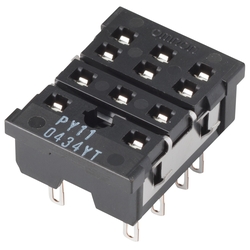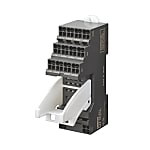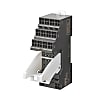(!)NOTE : Windows 7 users won’t be able to use some latest features of eCatalog/WOS since Microsoft is ending support for Windows 7 on 14 Jan, 2020. Please upgrade your system for uninterrupted services.
- Notice of End of Sales for Economy Series Pneumatic Equipment Category. More information.
Relay Sockets(Number of Relay Poles:Other)
Brand |
|
|---|---|
| CAD |
|
| Days to Ship |
|
2 items
- Sort By
-
You can add up to 6 items per a category to the compare list.

Option Product for Relay Common Socket
OMRON
Common use optional products for relays: square sockets, round sockets
[Features]
· Square sockets and round sockets are available in front connection and back connection type.
· Finger protection type also available.
· Retention brackets, crossover bar for model PYF also available.
· Non-screw series added.- Volume Discount
Number of Relay Poles Wiring Method Mounting Type Number of Socket Pins Socket Type Representative Standard Dimension vertical(mm) Dimension width(mm) Dimension depth(mm) Other Soldering / Other Surface connection / Backside connection 8 ~ 14 Square shape socket / Circular Socket CE / UL / CSA - - - From: ₹ 125.00 Days to Ship: Same day or more  Same day or more
Same day or more
-
You can add up to 6 items per a category to the compare list.

Push-In Plus Terminal Block Socket PYF-□□-PU
OMRON
A Value Design for Panel product that increases the value of your control panels.
A Push-In Plus terminal block type that reduces labor has been added to the series of sockets for the MY Relay and G2R-S Relay.Number of Relay Poles Wiring Method Mounting Type Number of Socket Pins Socket Type Representative Standard Dimension vertical(mm) Dimension width(mm) Dimension depth(mm) Other Other Other - - UL / TUV / CSA 98.4 31 71.5 From: ₹ 572.00 Days to Ship: 5 Day(s) or more  5 Day(s) or more
5 Day(s) or more
| Brand |
|---|
| Product Series |
| From |
| Days to Ship |
| Number of Relay Poles |
| Wiring Method |
| Mounting Type |
| Number of Socket Pins |
| Socket Type |
| Representative Standard |
| Dimension vertical(mm) |
| Dimension width(mm) |
| Dimension depth(mm) |
You can add up to 6 items per a category to the compare list. | You can add up to 6 items per a category to the compare list. | |
| Brand | OMRON | OMRON |
| Product Series | ||
| From | ₹ 125.00 | ₹ 572.00 |
| Days to Ship | Same day or more | 5 Day(s) or more |
| Number of Relay Poles | Other | Other |
| Wiring Method | Soldering / Other | Other |
| Mounting Type | Surface connection / Backside connection | Other |
| Number of Socket Pins | 8 ~ 14 | - |
| Socket Type | Square shape socket / Circular Socket | - |
| Representative Standard | CE / UL / CSA | UL / TUV / CSA |
| Dimension vertical(mm) | - | 98.4 |
| Dimension width(mm) | - | 31 |
| Dimension depth(mm) | - | 71.5 |
Loading...
Configure
Specification/Dimensions
-
Number of Relay Poles
- 1
- 2
- 3
- 4
- Other
-
Wiring Method
-
Mounting Type
- Surface connection
- Backside connection
- Other
-
Number of Socket Pins
-
Socket Type
-
Representative Standard
-
Dimension vertical(mm)
-
Dimension width(mm)
-
Dimension depth(mm)
Related Categories to Relay Sockets
FAQ Relay Sockets
- Question: What are relay sockets and how do they function in an electrical circuit?
- Answer: Relay sockets are fundamental components in electrical systems. They serve as secure holders for relays, which are switches that control the flow of electrical currents. These sockets provide a stable connection point for relays, ensuring they function effectively. When a relay is inserted into a socket, it securely connects to the circuit, allowing it to open or close the electrical path as needed.
- Question: How do you install and replace a relay socket in different types of circuits?
- Answer: Installing or replacing a relay socket involves a straightforward process. You place the relay securely into the socket, ensuring it aligns correctly with the socket's pins. The socket then connects to the circuit, and when the relay operates, it opens or closes the electrical path. When replacing a socket, simply disconnect the old one and connect the new socket in its place.
- Question: How do relay sockets enhance the safety and efficiency of electrical systems?
- Answer: Relay sockets enhance safety by providing a stable and reliable connection for relays. This reliability ensures that electrical circuits operate as intended, reducing the risk of malfunctions or accidents. Efficiency is improved because relay sockets allow for easy replacement or reconfiguration of relays, simplifying maintenance and system modifications.
- Question: What are the different types of relay sockets and how are they utilized in various applications?
- Answer: There are various types of relay sockets, each designed for specific relay sizes and functions. They can be used in applications ranging from simple lighting control to complex industrial automation. Understanding the appropriate socket type for your specific relay is crucial to ensure proper operation.
- Question: How to troubleshoot common problems associated with relay sockets?
- Answer: Common relay socket issues include loose connections, damaged pins, or relay failure. Troubleshooting involves checking for loose or damaged parts and replacing the relay or socket as needed. It's also important to verify that the relay is compatible with the socket.
- Question: Can relay sockets be used in both AC and DC circuits, and how does their performance vary?
- Answer: Relay sockets can be used in both AC (alternating current) and DC (direct current) circuits. Their performance remains similar in both cases, as they provide a secure connection for relays. However, it's essential to use the appropriate relay socket and relay for the circuit type to ensure compatibility and safety.
- Question: What factors should be considered when selecting relay sockets for industrial applications?
- Answer: When selecting relay sockets for industrial applications, factors like voltage, current, environment, and the type of relay used should be considered. Ensure that the socket is compatible with the relay and suitable for the specific industrial conditions to guarantee reliable and safe operation.












How can we improve?
How can we improve?
Thank you for your time.
Your feedback is essential for our continuous improvement
Privacy Policy
Thank you for your cooperation.
Thank you for your time.
Your feedback is essential for our continuous improvement
Please use the inquiry form.
Privacy Policy